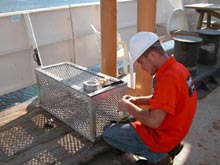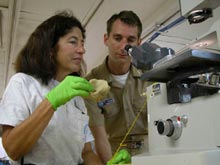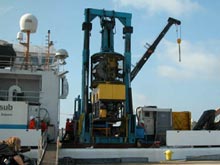
A Sonsub Inc. technician works until the last minute preparing the remotely operated vehicle (ROV) for the mission. Click image for larger view.
Patterns in Chaos: Isn't that what Real Science is all About?
September 8, 2003
Gary K. Wolfe
Marine and Environmental Education
Eau Gallie High School
Rollins College, Brevard, FL
I always tell my students that science is the search for patterns in chaos and that understanding these patterns allows us to make educated decisions and predictions about events in the world around us. This holds true not only in science, but also in all aspects of our lives. As a participant in the visiting "Educator at Sea" program, I am now witnessing one of those chaotic events and trying to make sense of what I observe. I have never been on a research vessel of this size so I really did not know what to expect when I came on board. Arriving at the St. Petersburg dock on Sunday was my induction into the hard work of pre-cruise preparations.
We started with a somewhat chaotic dance of unloading equipment from a rental van and, like ants in a hive, going into and out of the ship, making sure the supplies and equipment arrived whole and in working order. The activity on board the NOAA Ship Ronald H. Brown would easily be the envy of any department store during the holidays. Was it chaos or was there a pattern in this activity?
The next order of business was the task of setting up the equipment, lashing it down, and making sure that our temporary facilities were presentable for the scheduled media event the next day, involving tours of the ship and interviews with the chief scientists and the Sonsub Inc. crew. I have to say, by the end of the day I was impressed. The scientific staff from Harbor Branch Oceanographic Institution, the NOAA Office of Ocean Exploration, Sonsub Inc., C & C Technologies, and the crew of the Ron Brown put some pattern into what I thought was chaos. So much for first impressions! I should follow the advice I give my students: "You cannot judge a book by its cover."
The Media Event and More Mobilization
September 8, 2003

Researcher Shirley Pomponi shows LTJG Shawn Maddock a sponge during the media event. Click image for larger view.
By evening of September 7, most of the unloading and loading of gear was complete, but then more chaos ensued. Was I too quick to think that everything was going well? The dawn of a new day brought many new faces aboard the ship for the media event. Local reporters, the mayor of St. Petersburg, a film crew, and some NOAA employees came to tour the ship and learn about the research that will be conducted during this mission. I learned many years ago in an organic chemistry class that an important part of good science is being patient. That statement is being put to the test even as I write this log entry. The new word for today is "learning curve." As with the application of any new technology to uses for which it was not originally designed, various hurdles must be overcome. Mother Nature is also playing a role in some of our hurdles. Tropical Storm Henri delayed the arrival of some of the support equipment, and, thus, our mobilization. Today we have seen many hurdles, but like any good professionals practicing their trade, the crew and staff are overcoming them.
I conclude my first log entry of this bioprospecting expedition with the saying, "All good things come to those who wait." To any students reading this entry, looking for the important objectives and the lessons learned, they are: There may be patterns in chaos. The fun part is trying to recognize them when at first you might not see them.
The NOAA ship Ronald H. Brown will depart the port at St. Petersburg at midnight for a full steam to our first dive site, "Forcepia-land." The site is known for the vast amount of the red-colored sponge, Forcepia,found there. Stay tuned for exciting dive coverage from the bioprospecting mission!
Sign up for the Ocean Explorer E-mail Update List.






















